Newsletter June 2022
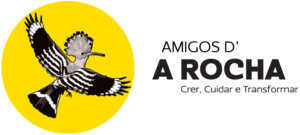
 Have you seen this beautiful black/green bird? Or this sky blue butterfly?
Have you seen this beautiful black/green bird? Or this sky blue butterfly?
Summer is here! Enjoy the sun 🙂
Helen & Filipa
S
N
A
P
SHOT

Edward Paul Abbey
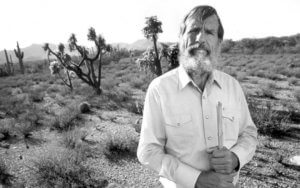
American author and environmental activist
Born: 29th January, 1927, USA
Died: 14th March, 1989, USA
Edward Paul Abbey, was born in Pennsylvania, USA, on the 29th of January of 1927; he finished his high school in Indiana, just before he was 18. After that he travelled through the southwest by foot or hitchhiking, during this period he discovered and fell in love with the “west”. He served in the military for 2 years, but had problems with authority and was “honourably discharged”. In 1951 he did his Bachelor in Philosophy and English, at the University of New Mexico and later in 1956 he finished his Masters in Philosophy.
He worked for almost 15 years as a park ranger in several National parks, maintaining trails and greeting visitors, during this period he gathered a large volume of notes and sketches, which was the basis for writing his first non-fiction book “Desert Solitaire”, 1968, (about the beauty of the Southwest), which became a cult classic. His next novel, “The Monkey Wrench Gang”, 1975, caused some controversy and launched a new offshoot of the environmental movement (sabotage, not violence, as means of protest). He wrote many books, fiction, non-fiction and documentaries, some were adapted to movies.
The writings of Edward Paul Abbey, are focused on environmental issues and are cited as an inspiration by environmentalists and other groups defending nature, although his ideas were also controversial, he held anarchist convictions and he blamed governments and industries as destroyers of nature.
IFO’s – Identified Flying Objects…
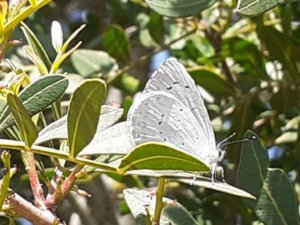
Holly Blue
(Celastrina argiolus, Linnaeus, 1758)
Photo by Filipa Bragança

Morphology: It is a small butterfly from the Lycaenidae Family, with a wingspan between 24 a 30 mm. The upper side of the wings is sky blue, with dark marginal edge on the hindwings; the underside is pale blue with fainted dark dots, white fimbriae (small hairs around the margin) on the hindwings and chequered on the forewings. Females have both wings broadly boarded with black. Two or three generations per year; the adults fly from January to October (depending on the location).
Habitat: Wide variety of habitats, scrublands, woodlands edges, riparian galleries, clearings and gardens. The adult prefers bramble hedges along water courses.
Distribution: Holarctic distribution (Northern hemisphere): Europe (missing only in the extreme north), North Africa, parts of Asia and North America.
Notes: The larvae feeds on several flowers and fruits, like ivy (Hedera helix), Genista sp., Arctium sp. and Holly (Ilex aquifolium). The larvae produces a sugary and nourishing liquid which pleases ants and makes them take care of the larvae.
Tweet… Tweet…


Glossy Ibis
(Plegadis falcinellus, Linnaeus, 1758)
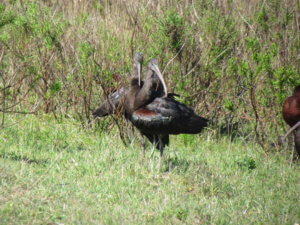
Photos by Guillaume Réthoré
Identification: It is a medium bird from the Threskiornithidae Family, with a wingspan between 88 and 105 cm and 55 to 65 cm in length. The plumage is totally dark brown (almost black), sometimes it is possible to see a green glimmer on the wings (depending on the light); the legs are long and dark, and the bill is long, bent down. Juveniles are brownish.
Habitat and Ecology: Prefers marshes at the edges of lakes and rivers, but also can inhabit lagoons, flood plains, wet meadows, swamps, reservoirs, sewage ponds, rice fields and irrigated cultivations. Breeds in colonies on the top of the trees, usually close to water. The diet varies seasonably, according to what is available: larval insects, worms, crustaceans and occasionally fish, frogs and small lizards.
Distribution: Worldwide: Europe, Central and South Africa, Asia, Australia, and Central America. This species is migratory and winters in Africa (populations from Europe). In Portugal it is present all year round, but not breeding.
Threats and Notes: Least Concern (LC) according to the Red List of the International Union for Conservation of Nature (IUCN). This species, until 2003, was rarely observed in Portugal, during the last years observations have increased. Big groups are now very common in the south of Portugal. Some breeding attempts were recorded south of Tagus.
DID YOU KNOW? 
-
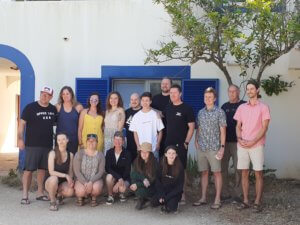 Between 22nd and 29th of May, A Rocha hosted a group from an American Church; they have been financially supporting Jasper and Tayler (the managers of the A Rocha Centre) in their work. During this week they get to know the work of A Rocha Portugal in all the different fields, like science, environmental education and community.
Between 22nd and 29th of May, A Rocha hosted a group from an American Church; they have been financially supporting Jasper and Tayler (the managers of the A Rocha Centre) in their work. During this week they get to know the work of A Rocha Portugal in all the different fields, like science, environmental education and community.

Common Linnet
- May, was the month for juveniles, at our ringing station, we caught several juveniles birds, like the Blackbird (Turdus merula), Eurasian Hoopoe(Upupa epops), Sardinian Warbler (Sylvia melanocephala), Common Linnet (Linaria cannabina), Eurasian Goldfinch (Carduelis carduelis), Great Tit (Parus major), Spotless Starling (Sturnus unicolor) and Barn Swallow (Hirunda rustica).
-
On the 11th May it was a glorious sunny day at Cruzinha for our Friends Event ‘Crafty Recycling’. Elisabete Freitas provided us with all the things we needed to create a heart, and also paper flowers. She was so skilled & made everything look so easy (which wasn’t always the case for some) but her patience enabled everyone to leave with at least one piece that they had created themselves. Thank you Elisabete for a wonderful morning, and thank you Violinda for a delicious lunch. Look out for a similar event later in the year, Angels, Stars & more for Christmas ⭐
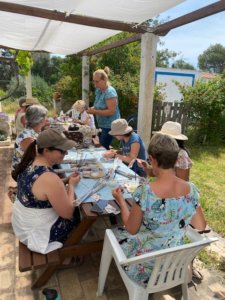

 INVASIVE SPECIES
INVASIVE SPECIES
Parrot’s Feather (Myriophyllum aquaticum, (Vell.) Verdc.)
Clade: Angiosperms 
Order: Saxifragales
Family: Haloragaceae
Origin: South America (Amazon River)
Size: up to 2 metres in height
The Parrot’s Feather is a perennial aquatic plant, can grow up to 2 metres and be woody at the base. The leaves are arranged around the stem like feathers (where it gets its name from), 4 to 6, oblanceolate and pectinate (comb shape). The flowers are unisexual (males and females in different plants), small, yellowish to pale pink, growing at the axils of upper emergent leaves. Flowers from May to October.
 This species is found growing in low-lying areas, freshwater streams, shallow waters, lakes, ponds and canals. Prefers warm areas rather than tropical, is native from South America (Argentina, Chile, Paraguay, Peru and Southern Brazil). Nowadays can be found in all continents except Antarctica. In 1906, was recorded in USA (Florida) and in 1919 in South Africa. The introduction was mainly by human (trade of aquatic plants for aquaria and ponds), once it is established it spreads downstream in the form of vegetative fragments or seeds; some plant fragments are also easily transported attached to ships or boats.
This species is found growing in low-lying areas, freshwater streams, shallow waters, lakes, ponds and canals. Prefers warm areas rather than tropical, is native from South America (Argentina, Chile, Paraguay, Peru and Southern Brazil). Nowadays can be found in all continents except Antarctica. In 1906, was recorded in USA (Florida) and in 1919 in South Africa. The introduction was mainly by human (trade of aquatic plants for aquaria and ponds), once it is established it spreads downstream in the form of vegetative fragments or seeds; some plant fragments are also easily transported attached to ships or boats.
The Parrot’s Feather it is considered an invasive species in many countries, it is a particular problem of small water bodies, irrigation, channel networks and small streams, impedes flow and causes several environmental problems like water deoxygenation.
POPPED UP

Family: Linaceae
Identification: It is an annual herbaceous plant, can grow between 10 and 50 cm in height. The stem is erect, branched and glabrous; the leaves are small, linear, lanceolate, with entire margins and green colour. The flowers are small, bright yellow and the fruit is a small ovoid capsule. Flowers from April to July.
Habitat and distribution: Meadows, pastures, fallow lands and grasslands, prefers rocky and dry soils. Native from Northern Africa, Southern Europe and Western Asia.
Notes: This species is naturalized in some parts of the world, like USA, Australia and New Zealand. In Australia it is considered an environmental weed.
French Flax (Linum trigynum subsp tenue, L.)

Photo by Filipa Bragança
DATES TO REMEMBER

1st June – Children’s Day
2nd, 9th, 16th, 23rd and 30th June- Cruzinha Bird ringing display & Moth Talk (10 am to 12 am). Book here
5th June – International Environment Day
10th June – Portugal Day (National Holiday)
13th June – Popular Saint Day – Saint António (Lisbon holiday)
16th June – Corpus Christi (National Holiday)
21st June – Summer solstice
24th June – Popular Saint Day – Saint Pedro
29th June – Popular Saint Day – Saint João (Porto holiday)
Thank you for supporting the Friends of A Rocha Portugal
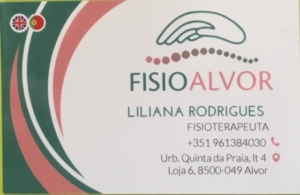
Physiotherapy, Massages (relaxation, sports, therapeutic)
Other therapies
Beauty (manicure, pedicure, hair removal, facials)
Open Monday to Friday

Dr Roy Rodrigues
Av. Do Brasil, Qta das Palmeiras, Lt P2, R/c A, 8500-299 Portimão
(+351) 282180683
royaldente@gmail.com
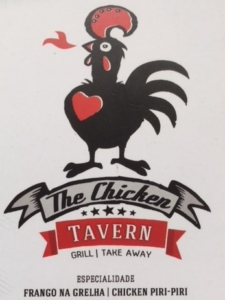
Urbanização Mar e Serra n° 47, Alvor
8500 – 783 Portimão
(+351) 911597735
Thought of the month 
“One of the first conditions of happiness is that the link between man and nature shall not be broken.”—Lev Tolstoi, Russian writer, 1828 -1910

LETS BE GREEN – LETS BE GREEN – LETS BE GREEN 
Deforestation, in a way is associated with paper production, but is that true?
- Paper and wood products account for 10% of total deforestation, 90% comes from cattle, soybean plantations and palm oil plantations
- In 2017, 123.6 million hectares of land were used to grow 352.6 million tonnes of soybeans. The biggest producers are USA, Brazil and Argentina. In Brazil, it is estimated that 29% of deforestation is linked to soy production. 75% of soy produced is used to feed cattle, chickens, pigs and fish. Most deforestation is linked to meat consumption. In reality, if we used all cropland available in the world to produce plant based food for humans, we would be able to feed a billion people, with no deforestation!

- Over 420 million hectares of forest have been lost since 1990
- 2 400 trees are cut down each minute
- 25,8 millions of hectares of forest were lost in 2020, double the amount of forested land lost in 2001
- Tropical deforestation contributes about 20% of annual global greenhouse gases emissions
LETS BE GREEN – LETS BE GREEN – LETS BE GREEN
Yellow Legged Gull (Larus michaellis) Census – Results
 In 2021, A Rocha took part in the National Census of Yellow Legged Gull (Larus michaellis), organized by SPEA (Portuguese Society for the Bird Study) and ICNF (Institute for Conservation of Nature and Forests) and aimed to estimate the number of breeding couples and their distribution area.
In 2021, A Rocha took part in the National Census of Yellow Legged Gull (Larus michaellis), organized by SPEA (Portuguese Society for the Bird Study) and ICNF (Institute for Conservation of Nature and Forests) and aimed to estimate the number of breeding couples and their distribution area.
During the month of May, there were 7344 nests recorded and confirmed, 321 probable nests and 292 possible nests; according to these results it was possible to estimate between 7350 to 8000 breeding couples in Portugal (Continental Portugal, Açores and Madeira Archipelagos).
In Faro it was estimated that there were 910 to 927 breeding couples. The area of Portimão and Lagos, is one of the 4 areas with more abundance of couples in Portugal.
Read the full report here (available only in Portuguese)
Climate change- pollinators
Climate can be defined as long-term weather averages; scientists have been studying weather patterns for a long time and have observed drastic changes in the word’s weather patterns – climate changes. The weather during the seasons has become more extreme than it has been in the past. In some areas summers have become hotter and drier and in other areas winters have become longer and with more storms, but in general it’s characterized by a global warming. Some fragile groups such as pollinators are having difficulties to adapt and to survive.
A recent global analysis by the United Nations found that more than 40% of pollinator species may be at risk of extinction. In some protected areas in Germany, some studies reveal a fall of 76% of flying insect biomass between 1989 and 2016. In the Western Mediterranean, 70 % of the butterflies declined between 1994 and 2014. For a high quality and resilient pollination we need a wide variety of species. Pollinators and the plants they pollinate, form a complex web of relationships which create healthier and resilient plants and helps to bind ecosystems together.
Bees are very important pollinators (the major pollinator of around 73% of all the world’s cultivated crops), their body temperature it’s dependent on the temperature of the surroundings and this determines their activity; so global warming can, in this way, affect bee’s activity, behaviour and distribution. Indirectly, climate change can affect bees flower resources and their natural enemies.
Sustainability Champions 
Sustainability Champions from around the World– Looking at ways to curb pollution and waste management.
We would like to thank Daniel Hartz, the founder of Sustainability Champions for giving us the permission to share this information.
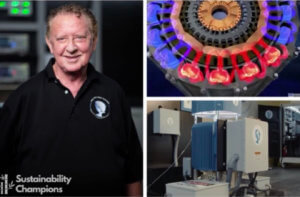 Robert Holcolm MD, Ph.D. is a neurologist and extremely prolific inventor, with hundreds of patents across a variety of disciplines. As a healer, Roberts’s real passion is cleaning up our world for his patients and all living beings. Some 15 years ago, the urgency of climate change led Robert to leave his medical practice and devote himself full-time to building a generator that produces 100% clean, sustainable and affordable electricity.
Robert Holcolm MD, Ph.D. is a neurologist and extremely prolific inventor, with hundreds of patents across a variety of disciplines. As a healer, Roberts’s real passion is cleaning up our world for his patients and all living beings. Some 15 years ago, the urgency of climate change led Robert to leave his medical practice and devote himself full-time to building a generator that produces 100% clean, sustainable and affordable electricity.
Through rigorous research, numerous prototypes and multiple patents, Robert has successfully overhauled the traditional power generator to invent a device the world thought was impossible. A power generation system that uses no fuel, has no moving parts, puts out zero emissions and runs totally silent. The Holcomb Energy System (HES) can be scaled to any application that requires electricity, producing power right where it is needed.
What is the power source that fuels the HES? The answer is simple. The HES runs on energy produced by the material from which it is constructed – electrical steel. The HES harnesses the electron spin in the iron atom – the primary ingredient of electrical steel – into usable electricity. That means we no longer have to mine, or frack, or drill, to enjoy our modern world.
The HES is currently powering a 12,000 square foot development centre and two commercial buildings, slashing power bills and carbon footprints.
Scalable everywhere electricity is needed – from consumer electronics, to transportation, homes, commercial buildings and even along the grid – the HES makes dead batteries, tailpipes and charging stations obsolete. Endless power, everywhere you need it.
The Holcomb Energy System is poised for commercialization and the possibilities are limitless. Let us put the last combustion engine in a museum, restore the polar icecaps, and make clean, affordable electricity for everyone. A better future awaits.

SPEA’s ‘scary bird’ wins Natura 2000 Award
 SPEA was awarded the European Commission’s Natura 2000 Award, in the Marine Conservation
SPEA was awarded the European Commission’s Natura 2000 Award, in the Marine Conservation category, for project MedAves Pesca, which worked closely with fishing communities to protect seabirds. In this project, conservationists and fishermen discovered that a kind of kite, dubbed a ‘scary bird’, is effective at keeping seabirds away from fishing nets, lines and boats, preventing bycatch – one of the biggest threats to seabirds, the most threatened bird group.
category, for project MedAves Pesca, which worked closely with fishing communities to protect seabirds. In this project, conservationists and fishermen discovered that a kind of kite, dubbed a ‘scary bird’, is effective at keeping seabirds away from fishing nets, lines and boats, preventing bycatch – one of the biggest threats to seabirds, the most threatened bird group.
Now, SPEA aim to get this and other solutions to as many fishing communities across Portugal and beyond; they promise more news on this soon.
More info here

Check the website for dates for organised tours
Guillaume Réthoré (Gui)- My life with birds: Pharao Eagle Owl (Bufo ascalaphus)
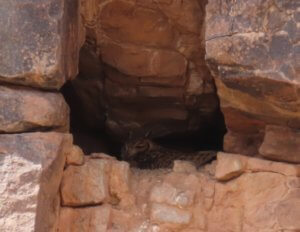 Last March, I was on a birding trip in Morocco organized by a friend. He called it “Opération Ascalaphe” (Operation Pharaoh Eagle Owl). The main target of the trip was this big Owl (the “cousin” of the European Eagle Owl). We had some info of a bird seen in a small ridge by the road. We had lunch by this ridge, already looking at all the holes, hoping to see this bird. After lunch, we made 2 teams, each one exploring a part of the ridge. I was in the one looking at what appeared the less interesting part. After a while, we looked at a hole and it was there! I called 2 of my team-mates a bit further away and they were looking at it, we had found it at the same time. A few minutes later the whole team was looking at this rare and difficult to find Owl. The mission was fulfilled, we could go back to the restaurant and have a nice tajine!
Last March, I was on a birding trip in Morocco organized by a friend. He called it “Opération Ascalaphe” (Operation Pharaoh Eagle Owl). The main target of the trip was this big Owl (the “cousin” of the European Eagle Owl). We had some info of a bird seen in a small ridge by the road. We had lunch by this ridge, already looking at all the holes, hoping to see this bird. After lunch, we made 2 teams, each one exploring a part of the ridge. I was in the one looking at what appeared the less interesting part. After a while, we looked at a hole and it was there! I called 2 of my team-mates a bit further away and they were looking at it, we had found it at the same time. A few minutes later the whole team was looking at this rare and difficult to find Owl. The mission was fulfilled, we could go back to the restaurant and have a nice tajine!
Text and photo by Guillaume Réthoré
Editor: Filipa Bragança
English proof reading: Helen Rodda
Portuguese proof reading: Lena Soares
Production controller: Helen Rodda
Email: friends.arpt@arocha.org
Thank you for supporting us!
Hope to see you soon!

 What makes a good Birthday present?
What makes a good Birthday present?


